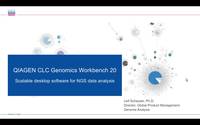Discovery and Research
Enabling High-Throughput Genomic Surveillance of Emerging SARS-CoV-2 Strains B.1.1.7 and B.1.351
455 views
In December 2020, the assumption that SARS-CoV-2 was a slowly-mutating virus began to change with the emergence of variants of concern in the United Kingdom and South Africa, the B.1.1.7 and B.1.351 variants, respectively. These lineages contained mutations in the spike protein that are estimated to increase the transmissibility of the virus by over 50% compared to earlier strains and provide potential avenues for immune escape. Unique spike protein mutational combinations continue to emerge globally, even in the first few weeks of 2021. While PCR is the clear choice for verification of diagnostic test results, next-generation sequencing (NGS) is the only high-throughput method for identifying novel genomic changes in the virus. In this new webinar, we will describe how QIAGEN’s QIAseq SARS-CoV-2 integrated workflow combines QIAseq chemistries and CLC Genomics Analysis software to deliver a scalable, high-performance solution for sequencing thousands of samples a week. The combination of these technologies enables unparalleled sequence-based tracking of new emerging strains and the capability for almost real-time genomic surveillance.
SPEAKERS Brian Dugan, M.S., Associate Director, Global Product Management, Genomics, QIAGEN Shawn Prince, B.S., Senior Field Application Scientist, Bioinformatics, QIAGEN
Related videos
Discovery and Research
Exploring IPA’s Analysis Match: An Overview
Learn about the new Analysis Match features and discover a new way to explore...
QIAGEN CLC Genomics
QIAGEN CLC Genomics Workbench 20 – scalable desktop software for NGS data analysis
In this webinar, Leif Schauser, Ph.D., Director Product Management Genome...
Discovery and Research
CLC Genomics Workbench 12
Introducing CLC Genomics Workbench 12 – an exciting new release that’s making...



